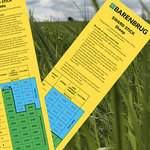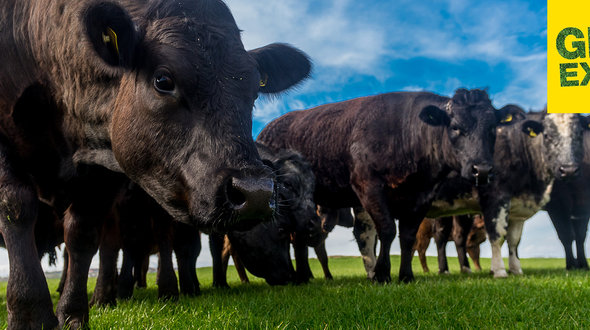Comparison data
An on-farm trial conducted by Ecosyl compared the two main silage methods – a multi-cut five-cut system and a conventional three-cut approach – to see if this argument stands up in the real world.
Harvesting began on 22 April, and although it was nip and tuck for DM yield between the two systems throughout the season, with the conventional system slightly ahead in tonnage by June, a true comparison was only possible once the final cut had been taken on 20 September.
The end results showed the multi-cut system delivered a total of 16.92t/ha, an increase of 0.92t/ha over the three-cut method. But Mr Smith says extra tonnes in the clamp wasn’t the only benefit of the multi-cut approach.
“The trial also found that grass from the five-cut system was more nutritious. It had an average digestibility (D value) of 72.7, compared to 69.7 from the three-cut approach. So overall, it equated to the multi-cut delivering 0.5 MJ more energy from each kilogram of grass.
“By combining the higher overall yield of the multi-cut with its improved quality, it was calculated to deliver 18,582 MJ/ha more energy over the year than the conventional system.
“Using a figure of 5.3 MJ of energy being required to produce 1 litre of milk, this equated to the multi-cut having the potential to deliver an extra 3,506 litres of milk from each hectare over the season. The trial also revealed a 3% increase in the average crude protein from the multi-cut,” he adds.
Because younger grass contains less stem material, it is easier to consolidate. However, getting the chop length and %DM right is critical as the tender nature of younger grass can make it prone to slippage in the clamp. Both Mhairi Dawson and Peter Smith suggest a DM of 30-33% and a 5cm chop length, as opposed to 28-32% DM and a shorter 2-3cm chop length of traditional systems.
Although these results are positive, it doesn’t mean multi-cut will work for all and there are key considerations to factor in when weighing up the options, including how much extra a contractor will charge for the increased workload.
Assessing machinery requirements
According to the National Association of Agricultural Contractors’ (NAAC) annual charges, a full silage contracting service in 2021 from mowing to clamping cost farmers £166.63/ha, so adding extra cuts is something that growers should be conscious of if making the change.
James Hutchinson, product specialist at Kuhn Farm Machinery, says the extra passes shouldn’t deter those from exploring multi-cut.
“Machinery use when making multi-cut silage is increased but the lighter cuts allow a faster operating speed, with less strain put on the machinery and talking to your contractor about your system before the season starts is crucial. Contractors might have the option to spread your workload further across a year, which benefits them during peak times.
“Using wider machinery, such as Kuhn’s high-output GF series tedders, in lighter crops can speed up wilting times as growers can cover the ground quicker after mowing and the lighter swards take less time to dry.”
A reason multi-cut can be seen as an attractive option is that it doesn’t require radically different machinery to that of a conventional system, imparts James. However, with lighter cuts, getting all the cut grass into the swath can be a trickier task than with bigger yields.
“An incorrectly set up rake, or a wider unit working on uneven ground, has huge potential to contaminate the sward with soil and small stones, placing undue stress on the following forager or forage wagons and reducing the quality of the material being ensiled.
“We are seeing a shift towards belt mergers, such as Kuhn’s MergeMaxx, as these have greater flexibility to bring lighter cuts into rows as well as heavier ones. The tine reel mirrors that of a forager and therefore is gentler on the smaller leaves, flicking material onto the belts rather than dragging it across the sward and potential damaging it. As the mergers sit on skids, rather than wheels, they adapt to ground contours better and help to protect the sward, too,” he says.
Sward options
Growing suitable species that can cope with frequent cutting and increased traffic are essential for multi-cut success, explains Mhairi Dawson, and getting advice on the right varieties for different soil types is key.
“When it comes to choosing the right ley there are a number of options. An Italian ryegrass (IRG) is ideal for short rotations of up to two years,” advises Mhairi. “However, they can be difficult to manage so might not be ideal for a first-time grower. Yields of 19-20t DM/ha are possible and it potentially needs cutting around every four weeks.”
Mhairi suggests perennial ryegrasses (PRG) are the most flexible but moving to a multi-cut system requires a mixture with a much closer heading date pattern, which is where hybrid ryegrass tend to be the most common.
The addition of white clover to a sward has the potential to boost protein levels and fix free nitrogen, while a lower bulk of grass, for instance in multi-cut scenarios, can also promote extra clover in the sward. Reseeding is important, but growers should be familiar with their current sward health before adding additional varieties and getting nutrition right during the year is essential, explains Mhairi.
“Growers applying slurry fertiliser, ideally by trailing shoe or dribble bar to avoid leaf contamination, should be doing so immediately after harvesting to give the sward the maximum available time to absorb the nutrients before the next cut. If this doesn’t happen, it increases the chances of enterobacteria in the silage.”
Additive benefits
Although multi-cut offers the potential for higher yields and quality, valuable nutrients can be lost if farmers get the conservation wrong. A higher protein content can increase buffering of the fermentation, and shorter cutting intervals between slurry applications risks contamination from slurry bacteria.
Further findings from the Ecosyl silage trial showed that using an additive preserved more dry matter and nutrients, while reducing the harmful effect of enterobacteria, the bacteria associated with slurry, Peter Smith explains.
“Where multi-cut was ensiled without an additive not only was the fermentation slow but enterobacteria numbers increased rapidly after ensiling.
“By comparison, when ensiled using Ecosyl, not only was the fermentation much faster, with the pH dropping rapidly, but enterobacteria numbers were up to 100,000 times lower, and the average DM loss was halved.”
Silage testing holds the key to understanding quality
Eurofins has developed on of the most comprehensive database of forage samples to allow farmers to analyse and benchmark the silage they produce. The global benchmark values and rumen character charts offer greater insight into the value of the forage and how this can affect the total mixed ration (TMR).
“Using Near-Infrared Spectroscopy (NIRS), we dry and grind forage samples before analysing them. This removes any inconsistencies in the shape and density of the sample to provide the most accurate result,” says Sophie Cath, forage testing specialist at Eurofins Agro UK.
“The properties of the forage samples are then fed into our unique rumen character charts that show the nutritional value of the silage against a number of parameters,” she adds.
Samples are analysed for dry matter content, pH levels, ME and 23 other parameters, and Sophie explains that using the tests indicates the nutritional value of forage to the rumen, which is a fundamental part of knowing what to include in a TMR.
“By using the tests, farmers will receive the most accurate forage measurement to enable them to maximise profit and yield by adjusting the ration to the optimum level. Weighing a ration is one thing but understanding the exact make up of that ration is a new level of precision,” she concludes.




